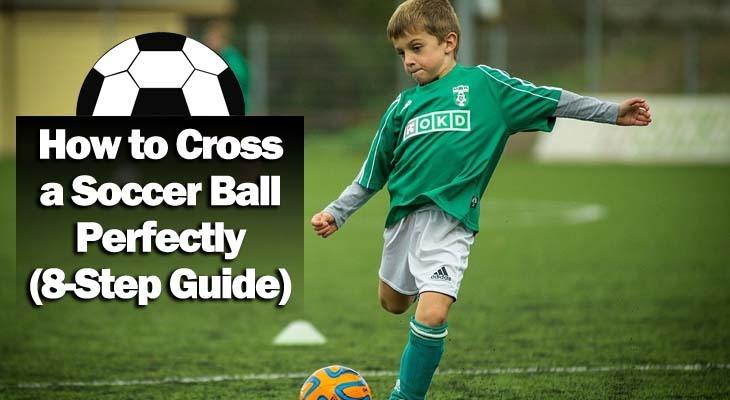How to Cross a Soccer Ball Perfectly (8-Step Guide)
Although learning how to cross a soccer ball seems like a relatively easy skill to improve, it is deceptively hard to master.
On any given weekend you'll see professional players regularly fail to beat the defender, overhit the cross, or play the ball in behind all of the strikers.
This is because you not only need to be able to strike the ball cleanly and accurately while on the run, but also have impeccable judgement on just where and when to place it.
On top of all of that, you need to first get in position to put in the cross and then have the technique to pull it off.
This all certainly makes for a challenging skill to get right on a consistent basis.
Which is why players such as David Beckham in his day and Man City's Kevin de Bruyne are so revered and exalted.
While it’s tough to get right, with patience and practice any player can master the cross if they understand the correct technique.
Let's take a look!

How to Cross a Soccer Ball (8 Steps)
Regardless of the position you normally play on the pitch, it’s a good idea to learn how to cross the soccer ball as it will surely come in handy at some point.
In today’s game, Liverpool's Trent Alexander-Arnold is one of the most feared crossers in the game and has contributed innumerable and invaluable assists from his fullback position.
Whether you are a box to box central midfielder, roving wingback, or marauding inside forward...
Here are eight steps to follow if you want to cross the soccer ball perfectly:
1. Set the Ball in Place
Before putting in a wicked cross, you must set the ball up perfectly before striking it.
This could involve you controlling the ball, knocking it the right distance in front of you to run on to, or even dribbling past an opposition player to get that extra bit of time and space.
Or it could be placing the ball on the ground, ready to take a free kick or corner.
2. Approach the Ball
In a fast-paced match that is fiercely contested, you will most likely approach the ball at a sprint.
As such, you need to time your run perfectly so that you not only arrive at the ball at the right time, but also with the correct distance and at an angle which allows you to strike it cleanly.
To give yourself the best chance of putting in a dangerous cross, approach the ball at a slight angle which will help you wrap your foot around the ball and whip it in.
While it can be hard to judge all this and evade, out-sprint, or out-muscle your opponent at the same time, your approach is critical to determining how good the cross is.
3. Decide Where to Put it
Just as important as the approach is the decision you make on where to cross the ball.
Do you want to:
- Do a low, hard cross to the near post?
- Cut it back to a midfielder sprinting into the box?
- Chip it to the back post?
- Etc
Taking a quick look at your options will help you weigh up the best choice that will most likely result in a goal.
You should look at who has taken up the most dangerous position, is unmarked, or is making a great run away from their defender.
If you don't have the time, however, it’s best to hit it into the mixer and hope for the best!
4. Decide Where to Strike
Once you have made your decision on where the ball will go, it’s time to put your technique and timing to the test and strike the ball.
Where you kick it will be determined by where exactly you want to deliver the ball.
If you decide on a low, hard cross or a cut back to the edge of the box, then you want to strike the ball roughly in its centre.
For a lofted cross, you want to hit the underside of the ball so it rises into the air.
5. Place Your Standing Foot
With the decision made and your approach to the ball timed and angled perfectly, you now want to place your standing foot next to the ball.
You don't want to be too near the ball as this will lessen your control over where it goes.
Nor do you want to be too far away as this means you stretch for it and again lose accuracy.
Placing your standing foot next to the ball while on the run is quite tough but with practice you'll learn just where and when to put it.
6. Strike the Ball
Having already taken a look up, made your decision on where to cross to, and set both you and the ball up perfectly... you are now ready to strike the ball.
To whip it in you want to wrap your foot around the ball and hit it with the upper inside part of your boot. This gives it lift and should allow you to curl it onto the head of the player you're aiming for.
Remember, the part of the foot that you use is dependent on what you are trying to achieve.
With a low, powered cross, for example, you will instead want to strike the ball hard and firm with either your laces or the inside part of your boot.
A lofted chip demands a different technique and approach entirely. Here, you want to get your foot under the ball as much as possible and deftly lift it into the box.
With all of these types of cross you must make sure you hit the ball hard enough and at the right height so that it has enough pace on it for the striker to divert it into the net.
Hit it too hard and it will sail over everyone and out for a throw in on the other side.
Too soft and the ball will either not arrive at the striker or they won't be able to get enough power on their volley or header to put it in the back of the net.
7. Follow Through
To increase the control and accuracy you have over the cross, you want to follow through when you strike the ball.
With a whipped cross this means letting your leg rise in the air after having struck the ball. It should feel like a natural movement and come quite easily with practice.
Conversely, after executing a deft, lofted chip, your foot should stay close to the ground as this will help the ball to rise up into the air.
8. Follow Up
Rather than sitting back and admiring your cross, you really want to immediately be on the move, ready for whenever the ball next comes your way.
Whether the fullback has blocked the cross, the defender has headed it away, or the ball has ended up ricocheting around the box, you want to be in position to react to whatever happens.
By following this simple step you will find that you’re ready to either attack again or fall back and defend, depending on the outcome of your cross.
Tips to Take Your Crossing to the Next Level
While some players have made a name for themselves with the wicked crosses they deliver on an impressively frequent basis, they all have other strings to their bow that enable them to do so.
As such, you must work on other aspects of your game as well as just your crossing. These skills and abilities will undoubtedly help you to improve your crossing and take it to the next level.
1. Dribbling
Being able to dribble past your opponent is a great way to win yourself more time and space at which to put in a cross.
2. Pace, Strength, and Stamina
While working on these three attributes will certainly help your all round game, they will also definitely help your crossing. Not only will you be able to outpace or outmuscle your opponent, you'll also be able to do it right at the end of the match when they are tiring.
3. Decision Making
While mastering your crossing technique is important, it is just as crucial that you work on your decision making skills. This will allow you to make the correct decision more often than not and put in a wicked cross to the right player, in the right place, at the right time.
4. Reading the Game
Similar to decision making, being able to read the game is a great way to maximise your crossing potential. Look to see if a defender is back-peddling and off balance or the goalkeeper is out of position and put in an early cross that creates havoc in their defence.
5. Practice, Practice, Practice
Key to mastering any skill is practice. Try and practice your crossing as much as possible, in a wide range of different scenarios. By practicing for every outcome and eventuality, you will ensure that you're ready and raring to go when game time comes around.
Conclusion:
While learning how to cross a soccer ball accurately and on a consistent basis is a difficult skill to master, it is doable with practice, patience, and perseverance.
Once you start contributing more assists to the team, you'll only want to practice further and get even better at whipping in a dangerous cross.
Crossing the ball perfectly is certainly a very satisfying skill to master so keep practicing, working on your technique + decision making skills, and you'll see the results in no time!

